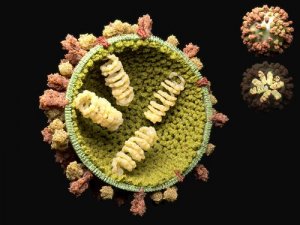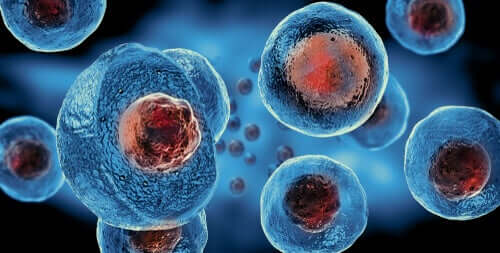The Reproductive Cycle of Viruses


Written and verified by the doctor Leonardo Biolatto
The reproductive cycle of viruses is complex and interesting. These particles don’t have cells and, therefore, can’t reproduce by themselves. To do it, they need a host, that is, a living organism. Inside this organism, viruses can replicate themselves, while outside they’re likely to be destroyed.
There are two different types of reproductive cycles of viruses:
- Lytic
- Lysogenic
The lytic reproductive cycle takes place when the virus enters a cell and immediately overwrites its genetic material on it. That is, it quickly and directly attacks the cells.
In the lysogenic cycle, however, the viruses insert themselves into the DNA of the cells of the host. When they do this it’s very difficult to detect them, and they are able to multiply without being noticed. In other words, they camouflage themselves inside the structure that they infect.
The steps of the reproductive cycle of viruses
Remember that viruses are structures that are only made up of nucleic acids and some proteins. Due to this, they are very small. Scientists don’t classify them as living beings, nor dead. However, they do two things that are characteristic of living beings: interaction and reproduction.
Viruses contain a genetic molecule that is almost always surrounded by a protein and sugar coat. When they arrive at a host cell they enter the nucleus and kidnap it: that is, they put it to work for their own benefit. After that, they start to multiply.

You might like to read: How Viruses Evolve: The Race is On
Adsorption and penetration phase
The first phase of the reproductive cycle of viruses is adsorption or attachment. This is the moment when the virus enters into contact with the organism it’s going to infect. Generally, this happens randomly: like when someone sneezes and there’s a person near them.
What happens next is that the virus recognizes the receptors of the cell it’s going to live in, and when it does, it adheres to the membrane of that cell. After that, it starts the second phase of the reproductive cycle of viruses, which is penetration. This is when the virus injects its genetic material into the cell it attached to.
The process is similar to what happens with a syringe, but in this case the virus injects genetic information. To do this it has to break the cell membrane, and it does this by releasing an enzyme.
Multiplication and assembly phase
Once the virus has penetrated the cell of its host and kidnapped it, the next phase of its reproductive cycle can start: multiplication. This is when the virus replicates its genetic material. The virus wants to create the components it needs to create new viral particles.
Since there are different types of viruses, there are different ways that they complete this process. When the process of multiplication is over, they start assembly. This is when different pieces are joined into a structure that forms new virions, or the body of the virus.

Release phase
The final phase is the release of the new virus bodies, or virions, outside the cell. These spread out until they find a new host cell, and then they repeat the whole reproductive cycle.
Some types of viruses force the release of the virions. That is, they leave by breaking the membrane of the cell in which they were created. If the virus has a lipid envelope, then they perform a process called budding. In this case, they take part of the host cell membrane and cover themselves with it.
As you can see, in this final phase the viruses break the cell membranes and this leads to the death of the cell. This process is repeated over and over: the viruses advance through the body killing cells.
The body activates the immune system to combat them and keep them from continuing to do damage. If the immune system can’t handle it, you have to use medication to help win the battle. If the medicine also fails, that’s when serious illnesses or even death occur.
Discover more: How To Differentiate Between Coronavirus and Allergies
Why is it important to understand the reproductive cycle of viruses?
Understanding the life cycle of viruses allows you to think of the best way to protect yourself from them. Preventing the spread of these particles is important, since there aren’t many effective antiviral medicines. Viral diseases can be light, like a cold, but also very serious, like AIDS or COVID-19.
The more you understand the reproductive process, the better you’ll be able to fight them. Vaccines and medicines come from this knowledge, which is why it’s so important.
All cited sources were thoroughly reviewed by our team to ensure their quality, reliability, currency, and validity. The bibliography of this article was considered reliable and of academic or scientific accuracy.
- Gomez-Lucia, E., Doménech, A., Benítez, L., Prieto, C., Simarro, I., & LePoder, S. (2019). Virus animales, su transmisión y enfermedades que producen, un MOOC para todos. VetDoc. Revista de Docencia Veterinaria, 3, 39-40.
- Vílchez, Glenda, and Guillermina Alonso. “Alcances y limitaciones de los métodos de epidemiología molecular basados en el análisis de ácidos nucleicos.” Revista de la Sociedad Venezolana de microbiología 29.1 (2009): 6-12.
- Mora, Nancy J., and Julieta Farina. “Propuesta de enseñanza del modelo de membrana celular basada en un modelo analógico y teatralización.” Revista d’innovació docent universitària: RIDU 11 (2019): 46-53.
This text is provided for informational purposes only and does not replace consultation with a professional. If in doubt, consult your specialist.








